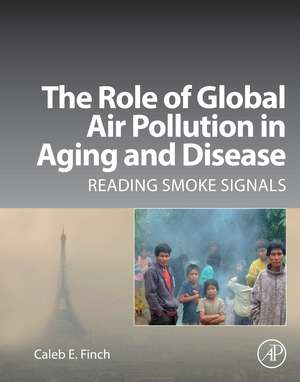The Role of Global Air Pollution in Aging and Disease: Reading Smoke Signals
Autor Caleb E. Finchen Limba Engleză Hardback – 29 ian 2018
In humans and animals, air pollution stimulates chronic inflammation in different organs, and genetic vulnerability to air pollution is being recognized, particularly for carriers of the Alzheimer risk gene ApoE4.
- Connects environmental pollution research to the human aging process
- Raises new issues relevant to the controversies on air pollution and global warming, challenging assumptions that lifespan will continue to increase in the 21st Century
- Examines the burden of air pollution to disadvantaged populations, with anticipated greater impact in developing countries which rely on fossil fuels for economic development in future decades
Preț: 854.86 lei
Preț vechi: 1222.65 lei
-30% Nou
Puncte Express: 1282
Preț estimativ în valută:
163.60€ • 169.01$ • 136.15£
163.60€ • 169.01$ • 136.15£
Carte tipărită la comandă
Livrare economică 19 martie-02 aprilie
Preluare comenzi: 021 569.72.76
Specificații
ISBN-13: 9780128131022
ISBN-10: 0128131020
Pagini: 218
Dimensiuni: 152 x 229 x 18 mm
Greutate: 0.48 kg
Editura: ELSEVIER SCIENCE
ISBN-10: 0128131020
Pagini: 218
Dimensiuni: 152 x 229 x 18 mm
Greutate: 0.48 kg
Editura: ELSEVIER SCIENCE
Public țintă
Researchers and clinicians studying biomedical aging. Also applicable to environmental biologists and public health workers.Cuprins
1. Air Pollution history in health and lifespan2. The nature of Air Pollution3. Air Pollution and adult disease4. Air Pollution in human development5. Air Pollution in future human health and life spans
Recenzii
"The author discusses what he calls the three smokes: cigarette smoke, outdoor or ambient airpollution, and indoor air pollution.The text is authoritative and well referenced. It is easy to read. Finch generally avoids the repetition and unevenness often seen in multiauthored books. He occasionally uses jargon unnecessarily, and he does not always clearly define terms on their first usage. There are occasional printing errors and at least one graphic illustration from the World Health Organization is of poor quality. The audience is not well defined: although the subject matter is suited for an educated general audience, the explanations at times are not clear enough for anyone not in the field. Despite these minor detractions, the volume is a nice compilation of the topic. Advocates for clean air as well as workers in this field will find it useful and worthwhile." --The Quarterly Review of Biology
